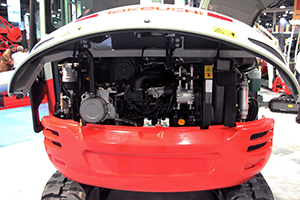
Fewer U.S.-made construction machines will be able to find a secondary market overseas in the coming years, resulting in a glut of used equipment in North America and a subsequent drop in used prices, according to a new study from market researcher Manfredi & Associates.
The study, titled "Quarantined Markets," investigates the aftermarket effects of the latest round of clean-diesel engines meeting U.S. Tier-4 Final emission standards and concludes that the need to run these machines on ultra-low-sulfur diesel fuel (ULSD) will create a competitive imbalance in global markets where such high-performance fuels are not widely available.
"The only way to compete in a competitive market like that is to reduce the used selling prices," writes Frank Manfredi, the study's author, in his newsletter Machinery Outlook. "Lower prices will result in lower residual values." The latest clean-diesel machines, like heavy-duty trucks, need ULSD to run efficiently.
As more Tier-4 Final machines turn over into their second lives, prices for used machinery in North America also could drop by 15% to 20% due to declining exports, says the study. It estimates that 10% of all used machines sold at U.S. auctions each year—or roughly 18,000 to 27,000 units—go to buyers in Latin America, where ULSD is not yet widely available.
The U.S. population of heavy machinery is approximately 3 million units, the study notes, and 20% to 30%, or 600,000 to 900,000 units, are sold annually as trade-ins or other means of disposal. Roughly 180,000 to 270,000 of those units are sold at auction, Manfredi estimates.
Many manufacturers already have announced the availability of so-called de-tiering kits that overseas buyers can use to swap out fuel injectors, remove exhaust scrubbers and reprogram engine computers. However, as Tier 4 Final machines are estimated to cost up to 25% more to buy and maintain than their older, less regulated versions, the added cost of de-tiering such engines may not make financial sense, Manfredi notes.
Those who are more optimistic about the exportability of Tier 4 machinery have said the global market for ultra-low-sulfur diesel will rise and that the improved productivity of Tier 4 machines will offset their up-front costs. Some manufacturers also have de-rated engine horsepower to skirt stricter diesel-emission rules, while others have introduced gasoline engines for machines below 50 hp, such as air compressors.
Caterpillar estimates its Tier 4 Final machines return an 8% improvement in fuel economy alone. Taking into account that urea-dose rates average 2% to 3% of diesel fuel burned to scrub tailpipe pollutants, these machines will provide 5% better "fluid economy."
Volvo is trying to balance the equation further by adding engine start-stop capability to its Tier 4 Final engines, providing a stated fuel economy benefit of 5% to 15% due to reduced idle time. Manfredi counters that these new clean-diesel machines must be 20% or more productive to clear the Tier 4 cost hurdle, but manufacturers are more optimistic.
"We expect operating cost to actually improve with Tier 4 Final," says Doug Mihelick, commercial manager for Caterpillar's machine engine group.



Post a comment to this article
Report Abusive Comment